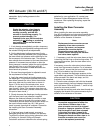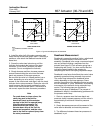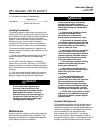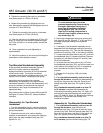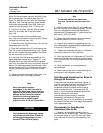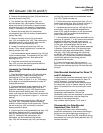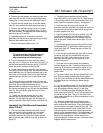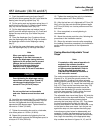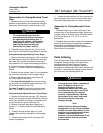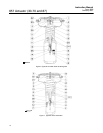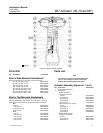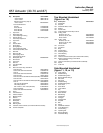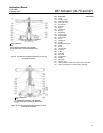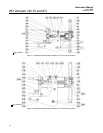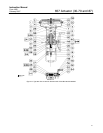
657 Actuator (30-70 and 87)
Instruction Manual
Form 1900
February 2007
14
11. Pack the needle bearing and race (keys 37
and 38) with lithium grease (key 241), and slide the
bearing onto the spring adjuster (key 12).
12. Put the spring seat and actuator spring (keys 11
and 6) into the yoke (key 9). Slide the upper sleeve
(key 34) onto the actuator stem (key 10).
13. Put the diaphragm plate and washer (keys 4
and 25) onto the actuator stem (key 10). Insert and
tighten the cap screw (key 3) to fasten the parts
together.
14. Place the diaphragm (key 2) pattern-side up
onto the diaphragm plate (key 4). Align the holes in
the diaphragm and the lower diaphragm casing
(key 5).
15. Position the upper diaphragm casing (key 1)
onto the diaphragm (key 2) and align the holes.
Note
When you replace actuator
diaphragms in the field, take care to
ensure the diaphragm casing bolts are
tightened to the proper load to prevent
leakage, but not crush the material.
Perform the following tightening
sequence with a manual torque
wrench for size 30-70 and 87 actuators.
CAUTION
Over-tightening the diaphragm casing
cap screws and nuts (keys 22 and 23)
can damage the diaphragm. Do not
exceed 27 NSm (20 lbfSft) torque.
Note
Do not use lubricant on these bolts
and nuts. Fasteners must be clean and
dry.
16. Insert the cap screws (key 22), and tighten the
hex nuts (key 23) in the following manner. The first
four hex nuts tightened should be diametrically
opposed and 90 degrees apart. Tighten these four
hex nuts to 13 NSm (10 lbfSft).
17. Tighten the remaining hex nuts in a clockwise,
criss-cross pattern to 13 NSm (10 lbfSft).
18. Repeat this procedure by tightening four hex
nuts, diametrically opposed and 90 degrees apart, to
a torque of 27 NSm (20 lbfSft).
19. Tighten the remaining hex nuts in a clockwise,
criss-cross pattern to 27 NSm (20 lbfSft).
20. After the last hex nut is tightened to 27 NSm (20
lbfSft), all of the hex nuts should be tightened again
to 27 NSm (20 lbfSft) in a circular pattern around the
bolt circle.
21. Once completed, no more tightening is
recommended.
22. Mount the actuator onto the valve, following the
procedures in the Installation section.
23. Return the actuator to service after completing
the Loading Connection procedure in the Installation
section and the procedures in the Adjustments
section.
Casing-Mounted Adjustable Travel
Stops
Note
If repeated or daily manual operation is
expected, the actuator should be
equipped with a manual top-mounted
or side-mounted handwheel. Refer to
the Top-Mounted Handwheel and
Side-Mounted Handwheel sections of
this instruction manual.
The casing-mounted adjustable up travel stop
(figures 14 or 15) limits the actuator stroke in the
upward direction. To adjust, first relieve actuator
loading pressure before removing the travel stop cap
(key 187, figure 14 or 15). Loosen the travel stop nut
(key 137). Then turn the travel stop stem (key 133)
clockwise into the diaphragm case to move the
actuator stem downward (or counter-clockwise to
move the stem upward). Finally, tighten the travel
stop nut and replace the travel stop cap.
The adjustable down travel stop (figure 16) limits the
actuator stroke in the downward direction. To adjust,
first relieve actuator loading pressure before
removing the travel stop cap (key 187). Then loosen
the jam nut and adjust the stop nut (keys 189
and 54) either down on the stem to limit travel, or up
on the stem to allow more travel. Lock the jam nut
against the stop nut, then replace the closing cap.
Instructions are given below for disassembly and
assembly. Perform the disassembly only as far as
necessary to accomplish the required maintenance;
then, begin the assembly at the appropriate step.
Key numbers are shown in figures 14, 15, and 16.



